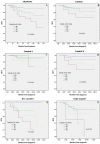Lymph node status in different molecular subtype of breast cancer: triple negative tumours are more likely lymph node negative
- PMID: 28903439
- PMCID: PMC5589678
- DOI: 10.18632/oncotarget.15022
Lymph node status in different molecular subtype of breast cancer: triple negative tumours are more likely lymph node negative
Abstract
Background and objectives: To investigate the association between different molecular subtype (MST) and the axillary lymph nodal (ALN) status.
Materials and methods: A total of 528 female patients with primary breast cancer were collected. Survival estimates were calculated using the Kaplan-Meier method, univariate and multivariate logistic regression models.
Results: Triple negative and Luminal A breast cancers were more frequently node-negative (N0) when compared to Luminal B and Her-2 positive cancers (77.4% and 73.4% vs. 45.3% and 40.0%, respectively; P < 0.0001). We observed a clearly significant difference among ALN status in patients with Her-2 positive (P = 0.001) and Luminal B (P < 0.0001) breast cancer. While no significant prognostic diffreence among different LN status was detected in the Triple negative (P = 0.070) and Luminal A subtype (P = 0.660). On the other hand, we detected no prognostic diffreence among different MST in N1 and N3 subgroups (P = 0.569 and P = 0.484, respectively). Multivariate analysis showed that lymph node status (P < 0.01), molecular subtype (P < 0.01), and tumor size (P < 0.01) were significantly and independently prognostic factors. The c-index of the prognosis nomogram for recurrence prediction was 0.70.
Conclusion: Triple negative breast cancer is not associated more frequently with a higher number of involved nodes. The prognosis nomogram can predict the probability of recurrence patients within 3 or 5 years.
Keywords: breast cancer; lymph node status; molecular subtype; prognosis; triple negative subtype.
Conflict of interest statement
CONFLICTS OF INTEREST There is no conflict of interest.
Figures




References
-
- Yoshihara E, Smeets A, Laenen A, Reynders A, Soens J, Van Ongeval C, Moerman P, Paridaens R, Wildiers H, Neven P, Christiaens MR. Predictors of axillary lymph node metastases in early breast cancer and their applicability in clinical practice. Breast. 2013;22:357–61. https://doi.org/10.1016/j.breast.2012.09.003. - DOI - PubMed
-
- Viale G, Zurrida S, Maiorano E, Mazzarol G, Pruneri G, Paganelli G, Maisonneuve P, Veronesi U. Predicting the status of axillary sentinel lymph nodes in 4351 patients with invasive breast carcinoma treated in a single institution. Cancer. 2005;103:492–500. https://doi.org/10.1002/cncr.20809. - DOI - PubMed
-
- Crabb SJ, Cheang MC, Leung S, Immonen T, Nielsen TO, Huntsman DD, Bajdik CD, Chia SK. Basal breast cancer molecular subtype predicts for lower incidence of axillary lymph node metastases in primary breast cancer. Clin Breast Cancer. 2008;8:249–56. https://doi.org/10.3816/CBC.2008.n.028. - DOI - PubMed
-
- Perou CM, Sørlie T, Eisen MB, van de Rijn M, Jeffrey SS, Rees CA, Pollack JR, Ross DT, Johnsen H, Akslen LA, Fluge O, Pergamenschikov A, Williams C, et al. Molecular portraits of human breast tumours. Nature. 2000;406:747–52. https://doi.org/10.1038/35021093. - DOI - PubMed
-
- Wiechmann L, Sampson M, Stempel M, Jacks LM, Patil SM, King T, Morrow M. Presenting features of breast cancer differ by molecular subtype. Ann Surg Oncol. 2009;16:2705–10. https://doi.org/10.1245/s10434-009-0606-2. - DOI - PubMed
LinkOut - more resources
Full Text Sources
Other Literature Sources
Research Materials
Miscellaneous

